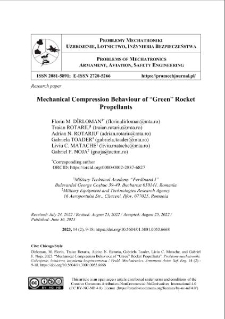Nasza Biblioteka Cyfrowa udostępnia 1 868 obiektów cyfrowych
Obiekt
Tytuł: Mechanical Compression Behaviour of “Green” Rocket Propellants ; Mechanical Compression Behaviour of “Green” Rocket Propellants
Współtwórca:
Traian ROTARIU, Adrian N. ROTARIU, Gabriela TOADER, Liviu C. MATACHE, Gabriel F. NOJA ; Traian ROTARIU, Adrian N. ROTARIU, Gabriela TOADER, Liviu C. MATACHE, Gabriel F. NOJA
Abstrakt:
The issues related to mechanical resistance of solid rocket propellants, which can appear during storage or handling of the launching system, are considered to directly influence the burning performance. Thus, in this study, four new types of composite rocket propellants, based on an environmentally friendly oxidizer (phase-stabilized ammonium nitrate), a metallic fuel (aluminium), and a “green” polyurethane-based binder (synthesized from an oligomeric isocyanate and a blend of polyester-polyols obtained through the catalytic degradation of polyethylene terephthalate), were subjected to compression mechanical analysis in order to highlight the importance of the binder on the response given by the tested materials subjected to compressive loads. The samples showed remarkable mechanical performances, the experiments allowing us also to determine the influence of the binder composition and fuel granulation on mechanical properties of the composite propellant.
;
The issues related to mechanical resistance of solid rocket propellants, which can appear during storage or handling of the launching system, are considered to directly influence the burning performance. Thus, in this study, four new types of composite rocket propellants, based on an environmentally friendly oxidizer (phase-stabilized ammonium nitrate), a metallic fuel (aluminium), and a “green” polyurethane-based binder (synthesized from an oligomeric isocyanate and a blend of polyester-polyols obtained through the catalytic degradation of polyethylene terephthalate), were subjected to compression mechanical analysis in order to highlight the importance of the binder on the response given by the tested materials subjected to compressive loads. The samples showed remarkable mechanical performances, the experiments allowing us also to determine the influence of the binder composition and fuel granulation on mechanical properties of the composite propellant.
Miejsce wydania:
Warszawa
;
Warszawa
Wydawca:
Wojskowa Akademia Techniczna ; Wojskowa Akademia Techniczna
Data utworzenia:
Data złożenia:
Data akceptacji:
Data wydania:
Rozmiar:
Identyfikator:
oai:ribes-88.man.poznan.pl:2670
Sygnatura:
DOI: /10.5604/01.3001.0053.6668 ; DOI: /10.5604/01.3001.0053.6668
ISSN elektroniczny:
ISSN drukowany:
Język:
Licencja:
kliknij tutaj, żeby przejść ; kliknij tutaj, żeby przejść
Właściciel praw:
Wojskowa Akademia Techniczna ; Wojskowa Akademia Techniczna
Strona początkowa:
Strona końcowa:
Tom:
Czasopismo:
Słowa kluczowe:
green rocket propellants, mechanical analysis, recycled polyurethane ; green rocket propellants, mechanical analysis, recycled polyurethane
Kolekcje, do których przypisany jest obiekt:
Data ostatniej modyfikacji:
15 paź 2025
Data dodania obiektu:
15 paź 2025
Liczba wyświetleń treści obiektu:
0
Wszystkie dostępne wersje tego obiektu:
https://ribes-88.man.poznan.pl/publication/3003
Wyświetl opis w formacie RDF:
Wyświetl opis w formacie OAI-PMH:
| Nazwa wydania | Data |
|---|---|
| Mechanical Compression Behaviour of “Green” Rocket Propellants | 15 paź 2025 |

